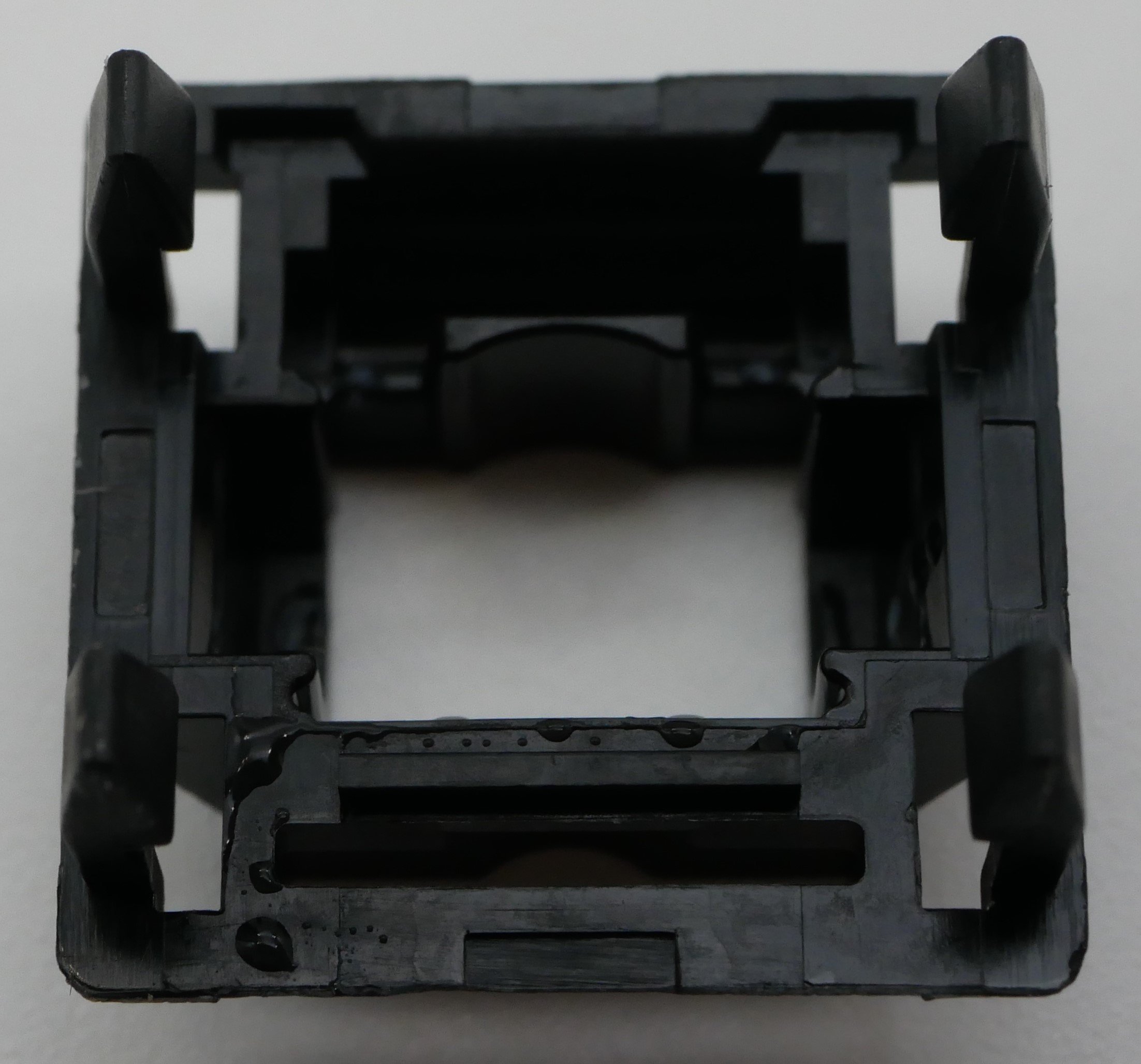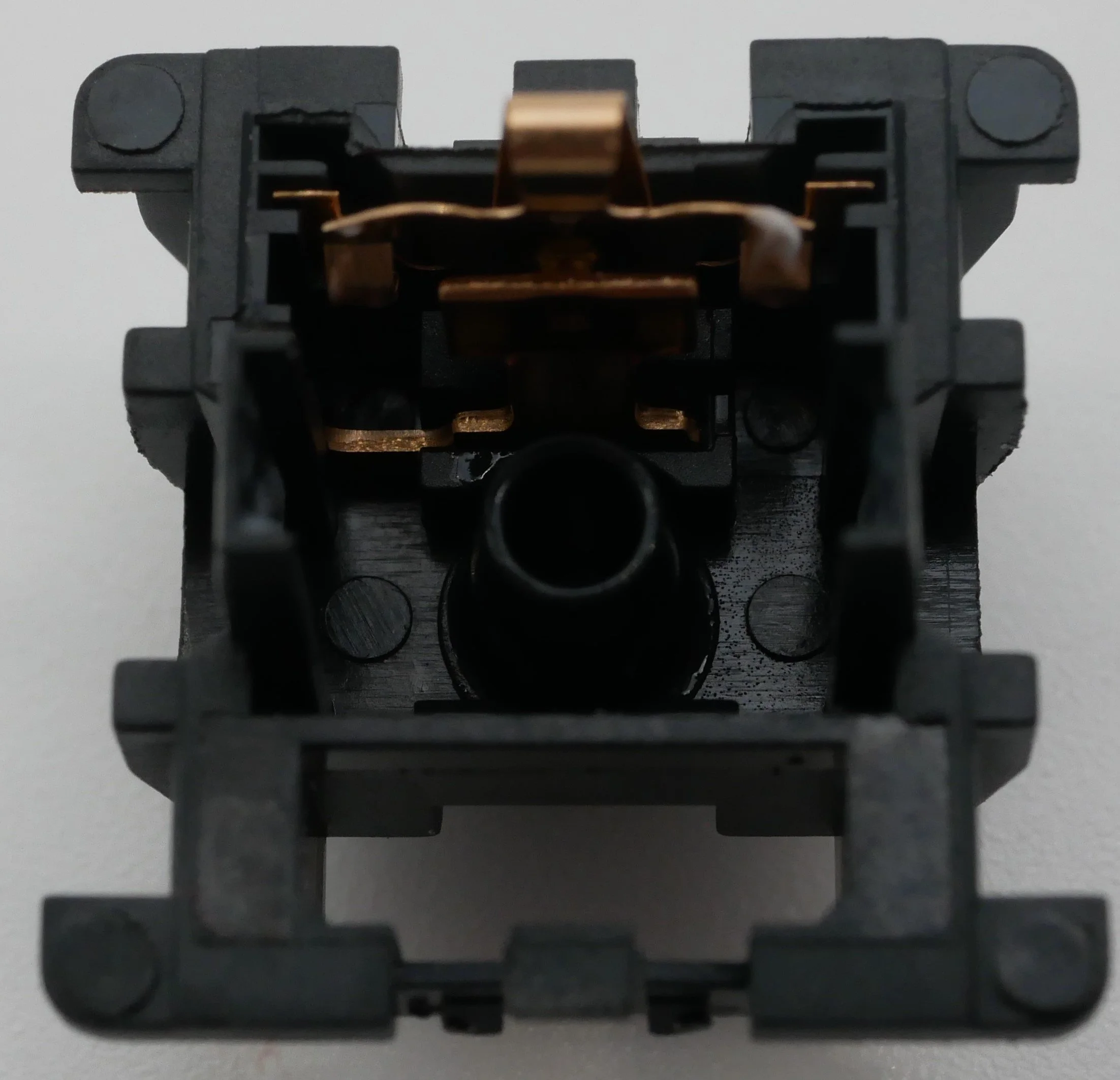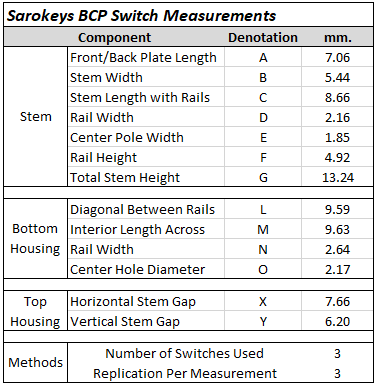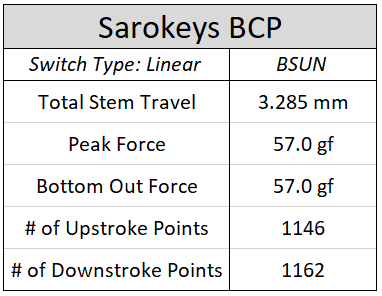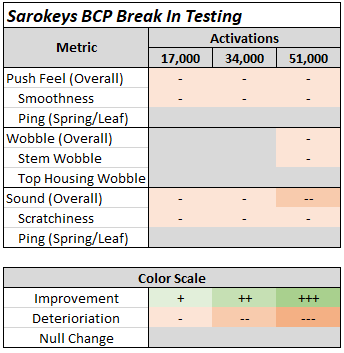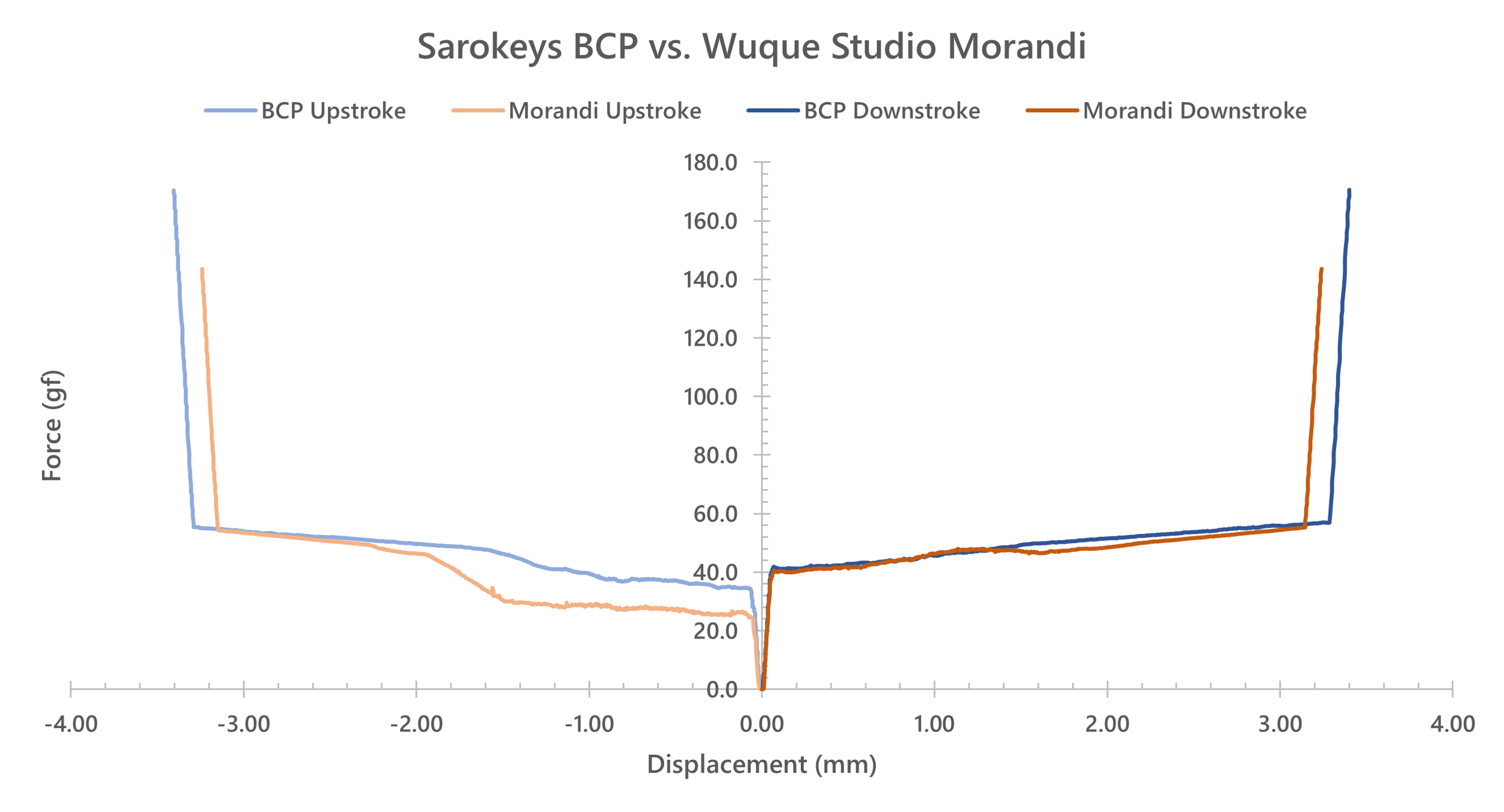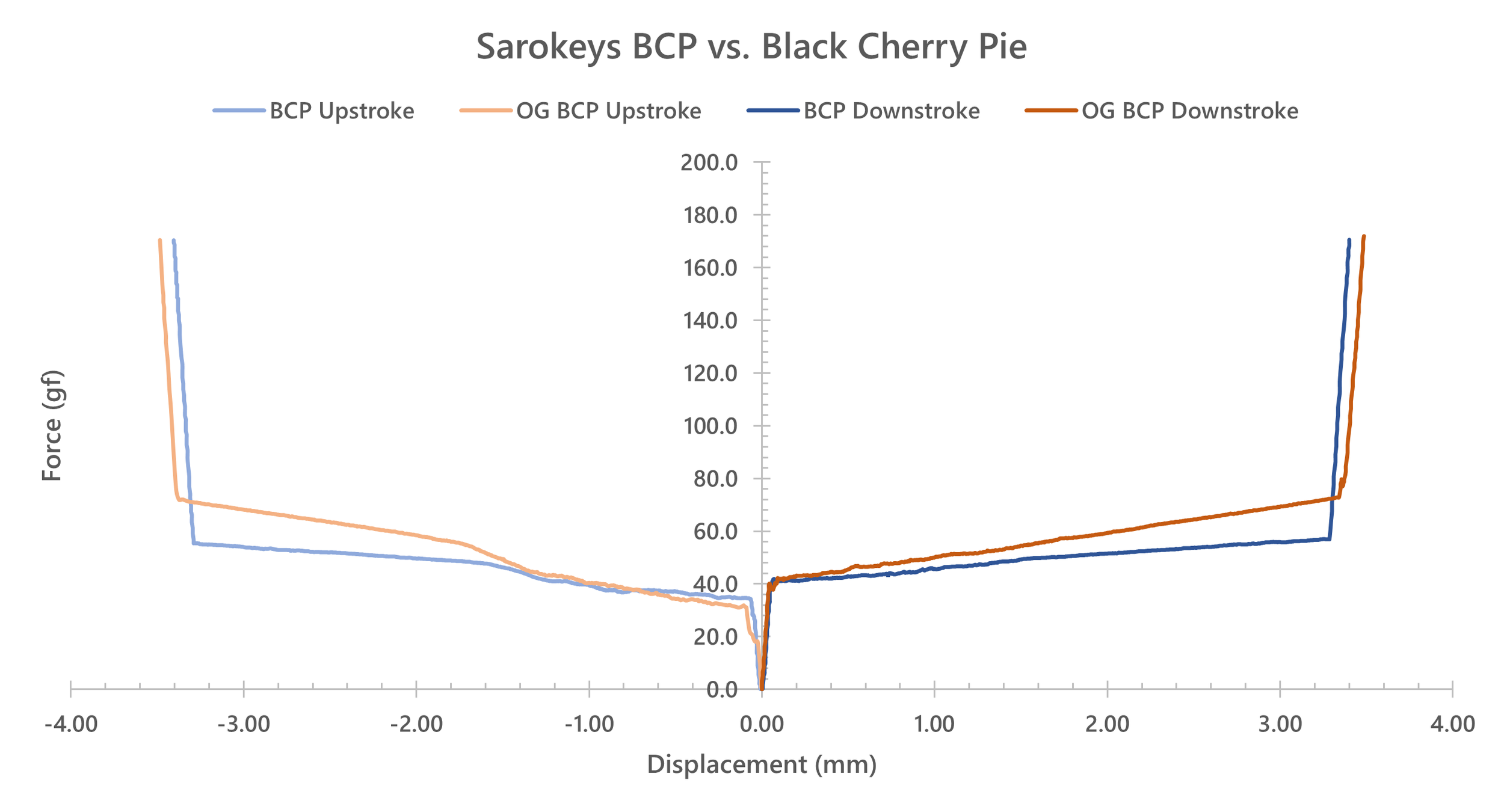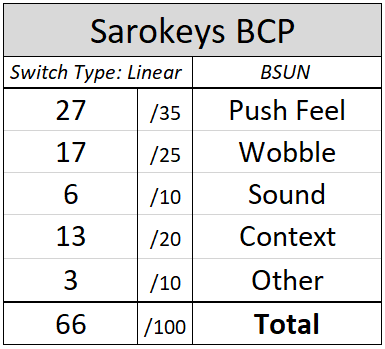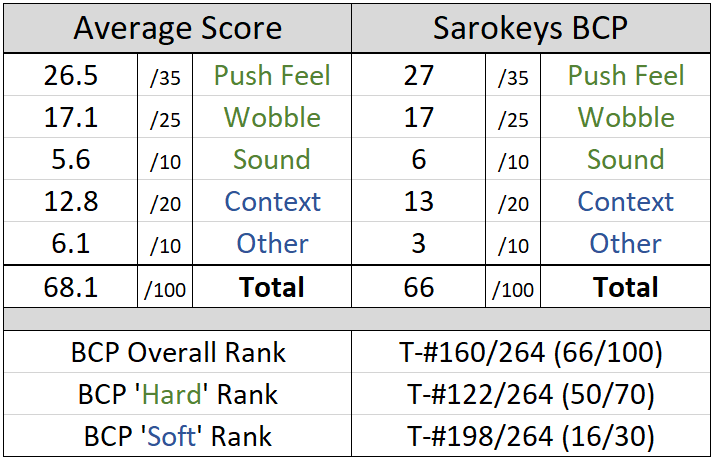Sarokeys BCP Switch Review
Easily the high point of my otherwise grueling work week leading up to this review was a package that I received in the mail from my lovely sponsor Dangkeebs. Rather than containing one of their newest releases of switches, I was greeted with a bag of coffee, known as ‘The Jarama’, that they partnered with coffee roaster Neko Coffee to make and sell on their site. While this is not the first time that a keyboard company has partnered up on roasting coffee and/or sold coffee related accessories, this is the first time that I’ve been able to participate in it and I have to say that I absolutely love how it turned out. Don’t get me wrong - I’m not exactly some crazy coffee fanatic pulling espresso shots and doing all sorts of crazy scientific testing on bean roasting, but I do like to think that I have a slightly more refined taste in coffee than the average person and have a decent pour over setup and bean grinder at home. The Jarama, itself, tastes pretty close to what the tasting card included with the beans states though in my less than reputable coffee opinion I get much more of the ‘hibiscus’ end of the bright and floral notes rather than the acidity from the berries and/or lemon tasting notes. I’m not exactly the biggest stan for lighter, acid forward coffees but I really am enjoying this batch of beans and it made for a warm addition to my Saturday morning edit session for this review. I sincerely hope that I’ll get a chance to try some of Dangkeebs’ other coffee releases if they do so in the future, or beans from other companies like MODE who have also made the keyboard-coffee product leap.
Figure 1: 'The Jarama' coffee from Dangkeebs.
While that introductory paragraph, in and of itself, could easily have been read as paid advertising for this coffee (it isn’t), it actually was born out of a much larger fancy that I have in non-keyboard related merchandise that has been released by keyboard companies and brands. In fact as I’ve mentioned these things at meetups, I’ve found that a surprising number of hobbyists aren’t even aware of these sorts of products or keyboard-adjacent merchandise are being made because they are so few and far between. Even though I enjoy special artisan keycaps, macropads, and stickers as much as the next guy, some of the keyboard coded products I’ve enjoyed more than anything throughout the years have little to do with the keyboards or switches that they are actually representing. A water bottle from Mekanisk, Hunger Works Studio hoodies, and this coffee all sit atop of my mind as things that I do or would use regularly given the opportunity, and it feels pretty cool to rep brands and designers from a hobby that I care so much about without having to spend 10 minutes describing why my keyboard is small, pink, and left handed. Even decorative pieces like the Gator Ron plushie from Novelkeys, the OG Keykollectiv plushies and bags, and especially prints or posters of designs like KeebTown are all things that fit into that niche and can decorate my apartment without drawing too many strange questions from guests that are visiting. As vendors have diversified their product offerings over the past few years and have begun taking more risks with odd, niche products alongside their bread and butter staples in keyboards and switches, I genuinely hope we get to see more of these sorts of things pop up in the years to come. And if this is the first time you’ve heard about T-Shirts, plushies, and coffee to go alongside your keyboard addiction I can’t recommend it enough.
Figure 2: Original Keykollectiv plushies from an r/mk post. Man I wish more artisan makers would make things like this…
Switch Background
This late into 2023, well beyond the 5 year mark since this madness that is the world of custom, MX-style mechanical keyboard switches has begun, I suspect that we are starting to tilt towards a critical mass of self-referential memes and design riffs. While most switches often don’t get me started off in the background section with the rambling incoherent sentences as if I’ve been drinking all weekend, the more and more I think about the Sarokeys BCP switches the more I feel lost between confusion and exasperation. Like the Holy Panda X and Glorious Panda switches which ripped off the Holy Panda frankenswitches before them and the Neapolitan Ice Cream switches directly inspired by Zykos, which were also a frankenswitch, I present the Sarokeys BCPs as a one-switch attempted analogue of the increasingly popular ‘Black Cherry Pie’ frankenswitch. As a result, we are now not one or two, but arguably at least four switches deep on the incredibly niche list of “switches that were inspired by switches that were combinations of parts from other switches” and its driving me insane. Did I also mention that Sarokeys, like many other brands in this day and age, are new as of the beginning of this year, have a tenuous connection to the west by way of a TaoBao page, and even more confusing switch history? It’s as if all the ways that a switch could possibly be historically ambiguous and difficult to write about were all crammed between a top and bottom housing in these BCPs. You know what, I’m not even going to attempt to unravel the Sarokeys part of that history.
Figure 3: I mean just look at this list of releases. Nyaberry definitely has a better understanding of what Sarokeys is doing than I do and even they have to end off the comment with ‘idk’.
My refusal to attempt to dig deeper into the history and prevalence of Sarokeys is both one that has been dramatically drummed up for engagement purposes and one that is born out of a genuine confusion as to the history of their releases outlined above by Switchmodders community member Nyaberry. While I’d like to think that I have a good grasp on switches being released, and doubly so when they are parts of extended families or series of releases, the Strawberry Jelly family which has dipped in and out of Huano and come in three or four various forms is still one that I’m struggling to fully discern where one release ends and another begins. Stack on top of this the fact that Sarokeys also seems to love the strawberry-themed and the cutesy, pink-colored aesthetic for their releases and I’m left even more puzzled than before as releases begin to blend into each other visually. If you’re interested in them, however, I’d suggest checking out their LD Studios TaoBao page and waiting for some of the western facing storefronts which appear to be in contact with Sarokeys, including Dangkeebs and Divinikey, who are also both sponsors of mine. While Sarokeys is fairly new and only popped onto the western keyboard hobby radar as of February 2023, with over a half dozen switch releases in only that short span of time between now and then, I doubt that they will be disappearing any time soon. Hopefully by the next time that we visit them I’ll be able to better unravel what is going on with them.
Figure 4: Sarokeys Purple Sakura switches freshly put up for sale as of a week ago. That's about as much as I can do to speak to their future planned releases.
Now as for the ‘BCP’ part of the Sarokeys BCP name, I can cover that part fairly easily. Born out of and popularized by the Discord server of keyboard design brand Smith + Rune, ‘Black Cherry Pies’ are frankenswitches that are constructed by combining a black Cherry MX top housing, an H1 switch bottom housing, and the stem from a Novelkeys Cream switch. While this definition was rigorous and specific at its onset, the community interpretation has widened quite a bit over the years with respect to the bottom housings, calling for “any JWK bottom housing” rather than specifically H1 switches. Assumedly, this is born out of the incorrect assumption parroted by many people in the community that “most JWK-made switches are just recolors of each other”. Regardless, given the recency of this frankenswitch’s birth, we can readily identify the exact minute that it graced the mechanical keyboard community:
Figure 5: First photo showing off the soon to be named 'Black Cherry Pie' frankenswitch combination.
Figure 6: Message a handful of minutes after the first photo showing off BCP frankenswitches officially donning them with their name.
Whether as a result of a concerted push for popularity from within the Smith + Rune community because of whyareyourunning being a community moderator, or born out of genuine community affection for the shortened travel distance and bottoming out onto the stem pole which was rare amongst linear switches at the time of their inception, this frankenswitch has become incredibly popular over the past three years. In fact, I’d argue that Black Cherry Pies have reached that sort of upper echelon of community-led switches that is occupied by frankenswitches such as Holy Pandas, Zykos, Ergo Clears and several stock offerings such as Zealios, T1s, and a few others. Much like those aforementioned switches on that list, it is very likely that this ascent to popularity is due in large part to them offering some performance differences at the time of their inception that were not nearly as commonly catered to by switch manufacturers nor vendors. However, after their inception the market has shifted towards providing these features in a fair amount switches and the concept of a linear switch with minorly reduced travel distances that bottoms out onto its stem pole is a lot more common than it was before. While some may look backwards and point to Black Cherry Pies as a catalyst for this shift, I’m not as easily convinced that that is as directly correlated as it may seem. Regardless of any historical interpretation, though, the sheer number of times which this has been referenced by the wider community at large, talked about in various keyboard forums, and asked about by beginners freshly new to the hobby makes its presence honestly a bit hard to leave out of the history books entirely.
Much like the other aforementioned switches which were created in stock, single factory form to emulate the designs of popular frankenswitches, Sarokeys created their BCP switches as an entirely BSUN made recreation of the popular Black Cherry Pie frankenswitch. While not perfectly matching the design of the original frankenswitches which inspired them as stated in a Geekhack Interest check for them by Unikeys on July 27th of 2023, they still boast similar housing and stem materials with added factory lubrication for improved out of the box usability. Available for sale shortly after this interest check was released in August of 2023, Sarokeys BCP switches fetch a current price of approximately $0.55 per switch depending on where they are purchased from with vendor support from nearly a dozen different vendors from all over the world. Even though the BCPs are still fairly new in the grand scheme of things, they do appear to have gained some small community attention as a result of their name based association with an incredibly widespread frankenswitch and thus have a decent likelihood of being continually stocked by some of these vendors for many months to come. No official plans regarding the longevity of their production nor improvements upon their design have been mentioned by Sarokeys nor BSUN to the best of my knowledge.
Sarokeys BCP Performance
Appearance
At the highest level, the Sarokeys BCP linear switches come in entirely black nylon housings with a barely pale-cream colored POM stem and an un-stylized, inverted ‘Sarokeys’ nameplate. Even in spite of the nameplate which can allow the BCP switches to be readily differentiated from original Black Cherry Pie frankenswitches, the switches also feature ever so slight differences in their appearance which can aid in differentiation. First, the top housings are noticeably more glossy and smooth in the Sarokeys BCP than the dull, rough grain matte finish of the Cherry top housings used in the original frankenswitches. As well, the BSUN-made stems for the Sarokeys BCP switches also appear a touch more pale and less cream-like in color. Beyond these outwardly obvious features, the Sarokeys BCP switches also feature single stage, 20 mm long silver colored springs. Further discussion of the mold based points of interest for the BSUN-made Sarokeys BCP switches can be found below.
Figure 7: Visual external comparison between Sarokeys BCP switch (Left) and original Black Cherry Pie frankenswitch (Right).
Figure 8: Sarokeys BCP switches and their components.
Looking first to the top housings of the Sarokeys BCP switches, there are only really a few features worth pointing out that aren’t immediately noticeable at a distance when viewing these switches. As mentioned above, the inverted ‘Sarokeys’ nameplate design is identical to those found on other switches championed by Sarokeys to date including the Strawberry Milkshakes and Purple Sakuras and can be considered to be indicative of a set or partial set of custom molds which were rumored to make these switches. Beyond this, the top housings feature a wide, rectangular LED/diode slot with a center circular cutout as is commonly found in many switches currently released without LED condensers. Interestingly, though, these top housings have their identifiable mold markings on both north and south sides of this circular cutout in the form of letters or capital numbers which are not necessarily always matching or different. To date, I don’t believe that I’ve seen this location of mold markings on the top housings of any switches which I’ve done a full length review on, though I can’t readily recall the last time BSUN was discussed with this level of mold detail here. Internally, the housings are otherwise bland and really only feature one point of note in the form of small bumps at the very top of the housings where the slider rails of the stem contact the housing at topping out. While it can be assumed that these may have been placed there with the design intent of helping dampen the topping out, discussion in the ‘Push Feel’ section below will prove them not to be all that effective in this regard.
Figure 9: Sarokeys BCP top housing external design showing smooth, glossy black finish, inverted 'Sarokeys' nameplate, and mold marking located in circular indentation of LED/Diode slot.
Figure 10: Alternative angle of Sarokeys BCP top housing external mold marking showing north and south side component within the LED/Diode slot circular indentation.
Figure 11: Sarokeys BCP top housing internal design showing subtle dampening bumps at the point of stem contact at topping out and slight factory lube misapplication.
Moving next to the stems of the Sarokeys BCP switches, these POM-based stems are rather bland and do not feature anything not previously covered in other reviews here. For the sake of coverage, though, the stems feature tapered slider rails, a strongly tiered center pole, mold ejector circles on the front plates above the stem legs, and are a touch longer than the average stem. Measuring in at 13.24 mm in total stem length, these stems are a tiny bit longer than my (running, 382 switch) stem length average measurement at 13.04 mm. As a point of reference, Novelkeys Dream Creams are purported to use the same molds as original Novelkeys Creams and feature a stem length of 13.28 mm, meaning that the BCP stems are at least seemingly close to the original frankenswitch design on this singular metric. As for factory lubrication, there is a generous, but not overwhelming amount of lube applied to the slider rails on either side of the stem as well as the tiniest amount on the stem legs for where they interface with the leaves in the bottom housings.
Figure 12: Sarokeys BCP stems showing tapered slider rails, strongly tiered center pole, and front plate mold ejector circles.
Finally arriving at the bottom housings of the Sarokeys BCP switches, there is again a notable lack of complexity or uniqueness in design than would be expected from a new age BSUN-made switch with custom molds. Internally, the BCPs have four ejector mold circles in the upper ring around the housing, a strong south side spring collar, a small ring around the base of the center hole, and a pair of mold ejector marks in the base of the housing not unlike what has been seen in many other brands previously. Beyond these points, though, there’s very little else to mention as the factory lubrication appears to have adhered to the stems and slider rails rather well and thus failed to gunk up in random portions of the bottom housings like recent switches such as Cherry MX2As. Externally, the bottom housings are incredibly unadorned again featuring only a small, numeric mold marking location between the metal PCB pin pads which is inverted and facing towards the center of the stem. The Sarokeys BCP switches come only in 5-Pin/PCB mount configuration.
Figure 13: Sarokeys BCP bottom housing interior design showing south side spring collar, mold ejector circles in base of housing, and slight factory lube application remaining on leaves.
Figure 14: Sarokeys BCP bottom housing exterior design showing inverted, single number mold marking between PCB pins and 5-Pin/PCB-mount design.
Push Feel
I mean – they’re linear switches, aren’t they? Shouldn’t that in and of itself say enough about them? All joking aside, though, these switches are surprisingly unremarkable both as modern, MX-style linear switches as well as given the fact that they are inspired by a frankenswitch which has gained a lot of attention over the past few years. While the factory lube out of the box does help their performance a bit over the raw, unimproved nature of the original Black Cherry Pie frankenswitch from which these are derived, its not by a whole lot. I would have expected a nearly flawless smoothness to these Sarokeys BCPs given the amount of factory lube that is present upon visual inspection, however there is still a very tiny amount of small grain scratch that is present to the push feel of these switches beneath that lube. Not only is this present in every switch as well, but the degree of scratch that is there is consistent across the entire batch that is received. The only real noticeable feature of their push feeling worth discussing is the slightly pointed and sharpened bottoming out that happens as a result of the long stem pole in their design, but even this isn’t all that standout given that the nylon tops don’t feel as deep as one would expect of nylon on their own. In fact, the housings are a lot more balanced than one might guess initially because of the pointed bottoming out not being so aggressive and the topping out being a bit more thinner and less firm feeling than traditional nylon housings seen throughout the years. While there is some small difference between either end of this switch, I am really struggling to identify it as anything meaningful because of just how across the board average this switch feels as a linear. There aren’t even little flairs of BSUN-related design or processing that rear their head here, for better or for worse. I guess a force curve is probably all there is left to share about the feeling of these Sarokeys BCPs.
Figure 15: Force curve diagram for Sarokeys BCP switch.
Sound
Medium in terms of overall volume with a pitch and overall presence that grows a little bit and pitches upwards at higher actuation speeds, the Sarokeys BCP also sound incredibly average and uninspired on top of feeling that way too. There’s not really any scratch sounds present. No spring nor leaf ping either. The housing collisions are a bit more balanced sounding than they show up in the push feeling of this switch, but even then, they provide a slightly pointed rapping sound at the point of collision which just sounds like slightly thinner nylon material. These sit almost incredibly in the middle of the spectrum on volume and on pitch with absolutely no flourishes or even imperfections that make them stand out in any meaningful capacity. To a degree, I almost wish that something sounded off about these switches as I genuinely had had my hopes set a bit higher from the last few times that I’ve reviewed switches inspired by the designs of frankenswitches. While not necessarily consistent in appearance nor magnitude, nearly all of these frankenswitch-inspired switches have felt packed with performance quirks, flairs, or oddities that made them feel like something worth writing home about. The Sarokeys BCPs, though, are damn near exactly what they are marketed as and are hiding not a single thing from you.
Wobble
Goddamn, even the stem wobble of these switches is average when considering all modern, MX-style modern mechanical keyboard switches. While it is maybe a bit worse than some of the best manufacturing tolerances which have been on display throughout 2023, there is a minor, likely unproblematic amount of equal magnitude N/S and E/W direction stem wobble in these switches. Cross batch consistency is also on point here as well, meaning that unless you’re super picky about stem wobble, you almost certainly won’t have a problem with the Sarokeys BCPs.
Measurements
If you’re into this level of detail about your switches, you should know that I have a switch measurement sheet that logs all of this data, as well as many other cool features which can be found under the ‘Archive’ tab at the top of this page or by clicking on the card above. Known as the ‘Measurement Sheet’, this sheet typically gets updated weekly and aims to take physical measurements of various switch components to compare mold designs on a brand-by-brand basis as well as provide a rough frankenswitching estimation sheet for combining various stems and top housings.
The latest in the content-adjacent work that I’ve picked up, the new ‘Force Curve Repository’ is now hosted on GitHub alongside the Scorecard Repository and contains all force curves that I make both within and outside of reviews. In addition to having these graphs above, I have various other versions of the graphs, raw data, and my processed data all available for each switch to use as you please. Check it out via the ‘Archive’ tab at the top of this page or by clicking any of the force curve cards above.
Break In
Break In Notes
17,000 Actuations
- During the first 17,000 actuations, factory lubrication present throughout the Sarokeys BCP switches begins to move around and relocate to its final resting places within the switch. As a result of this lube migration, these barely broken in switches begin to feel a bit more scratchier and sound a bit scratchier as well. It should also be noted that the switch to switch variability also begins to pick up a bit here as well, as the lube doesn’t appear to migrate equally across all switches broken in.
- Surprisingly, the Sarokeys BCP switches did not follow the average trend of loosening up on their stem wobble after 17,000 actuations. I’d have guessed from their average performance nearly everywhere else that they would’ve fallen into this trap as well.
34,000 Actuations
- At 34,000 actuations, the Sarokeys BCP switches hardly change all that much more than where they were at for the 17,000-actuation batch. While some switches may be a bit worse off than others as a result of that increased switch to switch variability, on the average they are not much different than where they were only a short while ago.
51,000 Actuations
- At 51,000 actuations, the long term break in effects on the Sarokeys BCP switches finally begin to show in the form of increased N/S and E/W direction stem wobble. It’s not common but also not all that far outside of the realm of feasibility that switches make it this far before experiencing some shift in the tolerances as a result of friction-based break in.
- As a result of the factory lube migration in these switches, the BCPs on average begin to sound a bit more thin, fragile, and hollow at the housing collisions out at 51,000 actuations.
Figure 19: Comparative force curve diagram showing no distinctive trend in change of Sarokeys BCP force curve diagrams throughout the break in process.
Comparison Notes to Other Notable Linear Switches
Note – These are not aimed at being comprehensive comparisons between all factors of these switches as this would simply be too long for this writeup. These are little notes of interest I generated when comparing these switches to the Sarokeys BCP switches side by side.
Figure 20: Switches for comparison. (L-R, Top-Bot: Gateron Oil King, Cherry MX2A RGB Black, Moyu Studio x XCJZ Snow Grape, Wuque Studio Morandi, Huano Fi, and Novelkeys Dream Cream)
Gateron Oil King
- The Gateron Oil King switches are quite a bit better lubed than the Sarokeys BCP switches, both from a single switch scratch reduction standpoint as well as a cross-batch consistency standpoint as well.
- With respect to stem wobble, the Sarokeys BCP switches are a bit worse than the Gateron Oil Kings in both the N/S and E/W directions. While it isn’t necessarily by all that much, it is still a noticeable enough difference that I imagine it could shave a few particularly picky individuals away from the BCPs.
- In terms of their overall sound profiles, the Gateron Oil King switches are a bit more quiet with slightly deeper, more firm sounding housing collisions than the comparatively thin and pointy housing collisions of the BCPs. This is especially true with respect to the bottoming out of the Sarokeys BCPs as a result of it happening on the stem pole.
Cherry MX2A RGB Black
- Of all of the switches on this initial comparison list, the Cherry MX2A RGB Blacks have the most similar push feeling to the Sarokeys BCPs in terms of their subtly scratchy while still being smooth from factory lube feeling. While the BCPs are a touch better than the MX2A switches in this regard, it isn’t all that much. The cross-batch consistency of this smoothness is a bit better in the Sarokeys BCP switches, however.
- Unlike the MX2A RGB Black switches, the scratch present in the Sarokeys BCPs isn’t nearly as large as a part of their overall sound profile. As well, the BCPs are a bit more quiet and less aggressive in their housing collision noises than these Cherry switches.
- In terms of stem wobble, while Sarokeys BCPs and Cherry MX2A RGB Blacks are comparable in their N/S direction, the E/W direction is much greater in the Cherry MX2A RGB Black switches.
Moyu Studio x XCJZ Snow Grape
- The housing collisions in the Snow Grape switches are not only a bit more quiet than the Sarokeys BCP switches, but they are also significantly deeper and more firm sounding. You could easily convince me that the Snow Grapes were made of some sort of magical ‘super nylon’ in a direction comparison with the reportedly “nylon” bottom housings of these Sarokeys BCPs.
- The Moyu Studio x XCJZ Snow Grape switches have less stem wobble in both the N/S and E/W directions than the Sarokeys BCP switches. However, the Snow Grape’s stem wobble breaks in much worse over time than the Sarokeys BCP switches.
- In terms of their out of the box smoothness, the Snow Grapes edge out the BCPs in having basically no noticeable scratch underpinning their perfect coverage of factory lube.
Wuque Studio Morandi
- It’s almost unfair to compare the stem wobble between these two switches. The Wuque Studio Morandi switches are simply hands down much less wobbly in both the N/S and E/W directions than the Sarokeys BCP switches.
- As well, it’s almost equally as unfair of a comparison between the smoothness of these two switches. Much like with the comparison made above for the Moyu Studio x XCJZ Snow Grapes, the Morandi switches are simply much more cleanly lubed and have almost nothing to their feeling besides the most subtle of scratchy undertones.
- Of all of the switches on this initial comparison list, the Morandi switches offer the most contrast from the BCPs in terms of their overall volume. Even though the Sarokeys BCP switches are fairly middle of the road for linear switches in terms of their overall volume, they are much more loud than the Wuque Studio Morandi switches.
Huano Fi
- The Huano Fi switches are noticeably more loud than the Sarokeys BCP switches, and especially so with respect to their pointed, just below sharp sounding bottom outs.
- Of all of the switches on this initial comparison list, the Huano Fis have the most similar N/S and E/W direction stem wobble to the Sarokeys BCP switches. That being said, though, the Fis are just the tiniest bit less wobbly across the batch that I received for testing.
- In terms of smoothness, these two switches are again fairly comparable to each other, though the grain of the scratch feels just a tiny bit larger in the Sarokeys BCPs and thus translates into a slightly more noticeable feedback in the push feeling than in the Huano Fi switches.
Novelkeys Dream Cream
- Even though the Novelkeys Dream Creams are much more smooth than their original counterparts because of the factory break in period, the lack of factory lubing does cause them to have an ever so slightly scratchier feeling than the factory lubed Sarokeys BCP switches.
- In terms of stem wobble, the Dream Creams just edge out the BCPs in both the N/S and E/W directions, though the gap is much more narrow than for the majority of comparisons made here in this list.
- The Novelkeys Dream Creams are much more high pitched and louder than that of the Sarokeys BCP switches. While part of this is likely due to a lack of factory lubrication in the Dream Creams preventing any sound dampening, a much larger portion is likely due to the differences in housing materials between these switches, as Dream Creams are made entirely of POM whereas the housings of Sarokeys BCPs are reported to be made of nylon.
Bonus Round
I guess I have to try and do something to make up for these switches. Or at least from this side of the keyboard it certainly feels as if they’ve been dull enough to warrant some extra pizzazz. Today I learned that pizzazz is actually spelled with two pairs of z’s according to Google. That’s kind of neat, I guess.
Figure 27: Switches for bonus comparisons. (L-R: NK Silk Mictlan Orange, Husky, and Black Cherry Pie frankenswitch)
NK Silk Mictlan
- Of all of the switches tested in both the initial list of switches as well as this bonus round, the Silk Mictlans have the most similar stem wobble to the Sarokeys BCPs in both the N/S and E/W directions.
- The smoothness of the NK Silk Mictlans is a touch better than the Sarokeys BCP switches, and as a result they have only the faintest scratch underneath their factory lube which is just barely less noticeable than that of the BCPs.
- Much like with the comparison made above with the Wuque Studio Morandi switches, the NK Silk Mictlans are noticeably more quiet and subtle in their sound profile than the Sarokeys BCP switches.
Husky
- While Kinetic Labs’ Husky switch is a bit more louder and sharper sounding at the point of bottom out than the Sarokeys BCP switches, it overall is a much more singular, deliberate, and well delivered sound. There’s no ambiguity about what they were going for there with the Husky switches and they weren’t meant to necessarily be comparable to full nylon housing switches like the BCPs.
- While the Sarokeys BCPs are a bit better than the Huskies in terms of their E/W direction stem wobble, the Huskies are better than the BCPS with respect to their N/S direction stem wobble.
- In terms of out of the box smoothness, the Husky switches are just the tiniest bit more smooth than the Sarokeys BCP switches and have a less noticeable scratch underpinning their push feeling.
‘Black Cherry Pie’ Frankenswitch
- It is kind of hard to directly compare the smoothness of these two switches given that the frankenswitch that I built for this review does not have any lube applied to it at all. I could, without a doubt, lube better than the factory lube present in the stock Sarokeys BCP switches, but then again, I suspect that even breaking in the Novelkeys Cream stems prior to building the OG BCP frankenswitches out of them would do a comparable enough job of reducing scratch.
- I mean, the performance of these two switches is pretty much the same. Even in spite of the slightly heavier spring that I used for my frankenswitch construction, these switches more or less feel similar on all not smoothness related points and bottom out at effectively similar distances.
- The one difference that I did note between the OG BCP frankenswitches and their Sarokeys and BSUN-inspired recreation is that the original frankenswitches had a much deeper, richer sounding bottom out than the Sarokeys BCPs.
Scores and Statistics
Note – These scores are not necessarily completely indicative of the nuanced review above. If you’ve skipped straight to this section, I can only recommend that you at least glance at the other sections above in order to get a stronger idea of my opinion about these switches.
Push Feel
Coming with a long POM stem in full nylon housings in similar fashion to the original Black Cherry Pie frankenswitches, the Sarokeys BCPs have a slightly reduced travel distance which results in a slightly pointed, but not necessarily sharp bottoming out that contrasts from the surprisingly thin topping out. Between those two ends, these switches feature factory lubing which does make the stroke feel smooth but with a noticeable, small grain scratch behind it.
Wobble
In terms of stem wobble, there is a noticeable but likely unproblematic amount of equal magnitude N/S and E/W direction wobble. While maybe a touch worse than the average compared to recent production trends, this is incredibly on par with historical switch wobble.
Sound
The Sarokeys BCPs are incredibly inoffensive sounding with a medium volume profile that is largely led by thinner than expected but not sharp nor flimsy sounding housing collisions. With a slight pitch up and separation in volume at higher actuation speeds, as well as a subtle peek through of that scratch into the sound profile, there is still some room for improvement here.
Context
Priced around $0.55 per switch at the time of release, these BSUN-made BCPs boast a similar set of performance metrics and constructions for nearly 1/3rd of the component cost to make the frankenswitches that inspired them. While a bit out of left field for Sarokeys of all brands to mimic them, they at least appear well supported by vendors and have a chance of a long run.
Other
I’m still left confused by these switches. They are, much like the original BCP frankenswitches, painfully average in their performance relative to today’s market. There’s nothing offered here, for better or worse, that couldn’t be gotten elsewhere and the entire idea of this switch rides on the concept of a BCP. This switch feels years late in the making and riding entirely on the name.
Statistics
If you are looking at this statistics section for the first time and wondering where the hell are the other 254 switches that I’ve ranked are, or what ‘hard’ versus ‘soft’ ranks refer to specifically, I’d encourage you to head on over to my GitHub linked in the table above or at the links in the top right hand of this website to check out my database of scorecards as well as the ‘Composite Score Sheet’ which has a full listing of the rankings for each and every switch I’ve ranked thus far.
Final Conclusions
I have to be truthful in admitting that I had not sat down, built, and tested a Black Cherry Pie frankenswitch ever until after I had started testing out the Sarokeys BCP switches. While this may shock quite a few people to read, consider that I have a pile of stock switches to test, measure, and write content about that is more varied and larger than most people may ever get to try in their time in the hobby. Unless it is in historical pursuit, or testing out switches for a review that are based on an existing frankenswitch concept that is widely accepted in the community, I very rarely ever frankenswitch switches at all. What prompted me to do my mixing and matching here, though, was not an attempt to see if the Sarokeys BCPs accurately recreated the feeling of the frankenswitches which inspired them, but rather because I didn’t get it. After having tried the Black Cherry Pie switches I still don’t get it. While the combination of a Cherry MX top housing, a JWK bottom housing, and a Novelkeys Cream stem may have provided a shortened travel distance, ‘bottom out on stem pole’ feeling that was interesting at the time of release around 3 years ago, how this switch didn’t die out very shortly afterwards as these tropes were beaten to death in more cost effective contemporary releases is beyond me. This sentiment is especially reinforced in my head when considering that large, well known to date long pole releases like Kinetic Labs Huskies and Neapolitan Ice Creams began hitting shelves less than a year after these switches were created. Even at the time of release, I’m not sure that I could have been convinced that the feeling of a Black Cherry Pie would have been worth the estimated $1.20-1.50 price tag. In today’s market and with the near fractal rainbow of options available to the general masses, I simply do not get how Black Cherry Pies are still being talked about as anything special.
Let me absolutely double down here so there is zero confusion in my stance: There is no reason that people should be making Black Cherry Pie switches for anything other than nostalgia-based purposes in 2023. What does the combination of a Cherry MX top housing, a JWK bottom housing, and a Novelkeys Cream stem provide that cannot readily be found in other existing stock switches except for an insane price tag and three piles of partial switch components? They’re not smoother, they don’t provide a unique feeling, and they effectively provide nothing novel – good or bad – that isn’t already present in the component switches that make them up nor in other existing stock switches. There is nothing novel about the feeling of a Black Cherry Pie switch in this day and age, and to that end the Sarokeys BCPs are nearly spot on recreations. Sure, they are a touch smoother because of the factory lubrication and they do have a slightly more thin feeling bottom out, but those subtle differences don’t even register under the overbearing weight of present day mediocrity that just crushes my opinion of these switches. Perhaps if Sarokeys had released these two or even three years ago my interpretation of them would be noticeably different, but given their almost asynchronous release into a market that already caters to all of their strengths and weaknesses, this just feels like its living on a name that isn’t worth much of anything anymore.
Sponsors/Affiliates
Mechbox UK
- A wonderful UK based operation which sells singles to switches that I’ve used above in my comparisons for collectors and the curious alike. Matt has gone out of his way to help me build out big parts of my collection, and buying something using this link supports him as well as my content!
KeebCats UK
- A switch peripheral company based out of the UK which sells everything switch adjacent you could ask for, they’ve been a huge help recently with my film and lube supply for personal builds, and they want to extend that help to you too. Use code ‘GOAT’ for 10% off your order when you check them out!
proto[Typist] Keyboards
- An all-things keyboard vendor based out of the UK, proto[Typist] is a regular stocker of everything from switches to the latest keyboard and keycap groupbuys. While I’ve bought things from the many times in the past, they also are a sponsor of my work and allow me to get some of the great switches I write about!
Divinikey
- Not only do they stock just about everything related to keyboards and switches, but they’re super friendly and ship out pretty quick too. Divinikey has been a huge help to me and my builds over the last year or two of doing reviews and they’ll definitely hook you up. Use code ‘GOAT’ for 5% off your order when you check them out!
ZealPC
- Do they really need any introduction? Zeal and crew kicked off the custom switch scene many years ago with their iconic Zealios switches and the story of switches today couldn’t be told without them. Use code ‘GOAT’ (or click the link above) for 5% off your order when you check them out!
MechMods UK
- A rising vendor based in the UK, Ryan and crew have been a pleasure to work with and have nearly everything you’d need to build your first or fourteenth keyboard. Go build your latest or greatest one right now with them by using code ‘GOAT’ at checkout for a 5% discount!
Dangkeebs
- A longtime supporter of the website and the collection, Dangkeebs has quite possibly the widest variety of switches of any vendor out there. Not only is their switch selection large, but it rotates and is constantly adding new stuff too. You’re going to need 5% off your order with my affiliate to save off the cost of all those switches!
SwitchOddities
- The brainchild of one my most adventurous proxies, SwitchOddities is a place where you can try out all the fancy, strange, and eastern-exclusive switches that I flex on my maildays with. Follow my affiliate code and use code ‘GOAT’ at checkout to save 5% on some of the most interesting switches you’ll ever try!
Cannonkeys
- Does anybody not know of Cannonkeys at this point? One of the largest vendors in North America with keyboards, switches, keycaps, and literally everything you could ever want for a keyboard always in stock and with an incredibly dedicated and loving crew. Follow my affiliate link above in their name to support both them and I when you buy yourself some switches!
Kinetic Labs
- One of the most well-rounded keyboard vendors out there, Christian and crew have been supporters of all my switch and switch-adjacent needs for some years now. I’m honored to have them as an affiliate and think you should check them out using my affiliate link above to support both them and I when you check out their awesome products!
Keebhut
- Want to try out some switch brands that fly under most vendor’s radars? Keebhut is always seeking out that next latest and greatest and has been super helpful in hooking me up with new brands over the past year. They are all about sharing that love as well, and want to give you 5% off your next order with them when you use code ‘GOAT’ at checkout!










